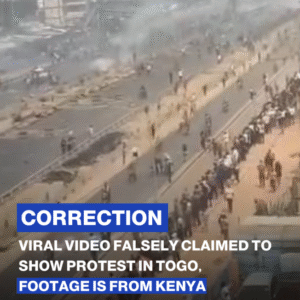A viral video circulating widely on social media was recently debunked after it was falsely claimed to show ongoing protests in Togo. Fact-checkers and regional news agencies confirmed that the footage actually originates from Kenya and was taken during demonstrations unrelated to the current situation in Togo.
The video, which shows large crowds of people clashing with security forces, was initially shared with captions alleging mass unrest in Lomé, the capital of Togo. It quickly gained traction online, spreading across platforms such as Twitter, Facebook, and WhatsApp, and raising concerns among viewers about a potential political crisis in the West African nation.
However, a closer examination by digital forensics experts and local journalists revealed several inconsistencies. Visual markers in the footage—including signage, license plates, and police uniforms—matched those commonly found in Kenya, not Togo. The video was traced back to protests in Nairobi earlier this year, which centered around economic grievances and tax reforms introduced by the Kenyan government.
Authorities in Togo have since issued a statement denying the existence of any recent large-scale protests, urging citizens to be cautious about misinformation online. The Ministry of Communication and Media emphasized the importance of verifying content before sharing and condemned the spread of false narratives that could cause unnecessary panic.
This incident highlights a growing trend of misattributed or repurposed protest footage being circulated to falsely represent political turmoil in other countries. Social media experts warn that such misinformation can quickly inflame tensions, especially in regions where political situations are already fragile or contentious.
In Kenya, the original protests that were featured in the misused video involved youth-led demonstrations against government policies, particularly tax increases. These protests had garnered international attention, with various human rights groups weighing in on the use of force by police and the government’s response.
Meanwhile, the use of that footage to depict unrest in Togo serves as a reminder of the critical role of media literacy in the digital age. Fact-checking organizations and newsrooms continue to call for more robust user education and stronger platform accountability to combat the spread of disinformation.
The misleading clip has now been flagged and removed from several major platforms, but screenshots and edited versions remain in circulation, prompting renewed calls for vigilance among users. Analysts suggest that deliberate manipulation of such content may be part of broader attempts to distort political narratives or incite division in specific regions.
Ultimately, while Togo remains politically stable at this time, the viral video episode underscores how easily misinformation can cloud public understanding and disrupt international perceptions. Experts advise that the public rely on verified news sources and official government channels for accurate updates, particularly in times of political sensitivity.


